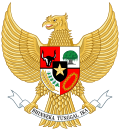| State of East Java Negara Jawa Timur | |||||||||
|---|---|---|---|---|---|---|---|---|---|
| State of the United States of Indonesia | |||||||||
| 1948 – 1950 (Sovereign state until 27 December 1949) | |||||||||
 East Java in the United States of Indonesia | |||||||||
| Historical era | Cold War | ||||||||
• State of East Java established | 26 November 1948 | ||||||||
• Merged with the Republic of Indonesia | 25 February 1950 | ||||||||
| |||||||||
The State of East Java (Indonesian : Negara Jawa Timur) was a federal state (negara bagian) formed on the Indonesian island of Java by the Netherlands in 1948. It subsequently became a component of the United States of Indonesia, but merged into the Republic of Indonesia on 9 March 1950.

